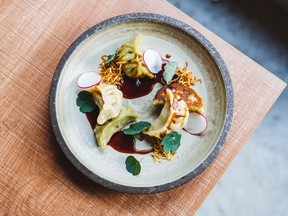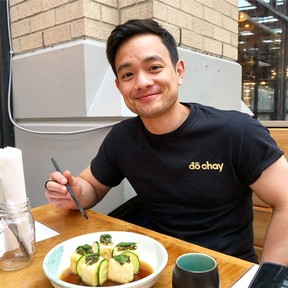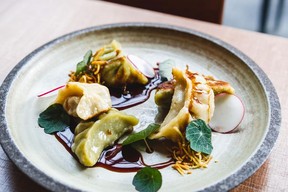Reviews and recommendations are unbiased and products are independently selected. Postmedia may earn an affiliate commission from purchases made through links on this page.
Recipe: Starting a vegan diet? Try these Spring Leak Potstickers

Osric Chau describes his journey to a plant-based diet and offers up this easy-to-eat dish that is also perfect for sharing at your family’s next potluck.

Article content
For many, the most difficult thing about starting a plant-based diet in your adult years will not be any meat or dairy cravings you had anticipated, but the interactions you’ll have with those around you.
Advertisement 2
Article content
Humans are social creatures, and the people we spend time with have an immense impact on shaping who we are and what we do. It is always a bit of a shock to see someone swimming against the current, and with meat consumption steadily rising since my parents were born and all the media coverage and traditions that have been built around its consumption, eating plants can be a bit of a spectacle in many circles.
Were I not as stubborn as I am, things might have gone another direction, cause at times, the peer pressure to fall back in line was overwhelming.
Most of my friends were supportive of my decision to cut out meat and dairy. Some were even helpful and would double and triple check that the restaurant we were going to would have some plant-based options available.
Advertisement 3
Article content
But there were the few that took offence. Maybe they were a little insecure about their own choices at the time, but they could not accept my choice, let alone understand why I had done it. Wafting the smell of meat my way to see if I’d be tempted was a common occurrence, a few just became fascinated about the comings and goings of my digestive track.
But even those friends weren’t so bad when you put them up against my family.
Growing up, I was told that eating this would be good for my heart, eating that would do wonders for my kidneys and lungs, everything we ate, we ate for a reason. All I know for certain is that it didn’t matter how many carrots I ate, I still needed glasses by the time I was nine.
For people who seemed to know a lot about food, my parents had a lot of trouble grasping the concept of a plant-based diet. I suppose in a culture where the offering of food is the primary language of love, it must have been stifling to be limited in what they could do.
Advertisement 4
Article content
After telling my parents I was no longer eating meat or dairy, I was presented with chicken and fish. Beef bone soups had all the bones carefully removed, but inexplicably it remained beef bone soup.

Our love for one another notwithstanding, I just kept refusing while they kept redefining what constituted eating meat. When our family went out for dinner — always the same rotation of restaurants — it was even slimmer pickings. I remember asking a waiter once if they had any vegetarian dishes and he suggested the beef and broccoli. I ate broccoli that evening.
It’s been a couple of years since that incident, and though just last night we ordered an eggplant dish off the vegetarian section that came fully mixed with pulled pork, it has never been easier to be plant-based, nor has it ever been easier to be friends with plant-based people.
Advertisement 5
Article content
But if meat consumption has been steadily rising these last few decades, where did it begin?
For those hoping to educate themselves on a plant-based lifestyle, there is a treasure trove of knowledge and insights that we can glean from looking into our ancestors and how they ate.
If we think of the hunter-gatherers at the dawn of human civilization, you might imagine a group of large Neanderthals with big clubs coming home with all sorts of prey. The reality is, however, the majority of hunting expeditions led by our hunter-gatherer forefathers were failures.
With the exception of the Inuits and other groups living in the arctic where plants do not grow, most of the diets of our ancestors subsisted much more heavily on the contributions of the gatherers.
Advertisement 6
Article content
When the agricultural revolution came around, so did a dependable source of food. Both crops and livestock spread far and wide, but even then, only the wealthy could afford to eat meat with livestock being vastly more resource intensive than crops.
For those of us who aren’t direct descendants of royalty, our ancestors ate mostly plants.
In traditional Chinese and Vietnamese dishes, one might add slivers of meat for flavouring, but still, the focus of a dish had always been on the vegetables. For example, what we may now call“veggie-forward.”
All this being said, telling anyone, let alone my parents, that they’re the ones adulterating our traditions and heritage, won’t do anyone any favours. So this week, we’d like to introduce from-scratch spring leek mushroom potstickers.
Advertisement 7
Article content
Spring leeks are now in-season, and you can find them at a farmers market, your local grocery store, and CSA boxes. With its sweetness and vegetable flavouring, leeks add depth and complexity to any soup, sauces or other dishes by virtue of just one ingredient.
Today we’ll be using them for potstickers. A dish that is easy to eat and a delicious offering for those we’d share a meal with. This dish might be particularly helpful at the next family potluck and its vegetable to meat ratio.

Osric Chau’s From-Scratch Spring Leek Potstickers
For the wrappers (can also buy pre-made dumpling wrappers)
2 cups AP flour
1 cup warm water
2 tsp canola oil
½ tsp salt
For the filling
150g (5oz) spring leek (roughly 1 small leek)
85g (3oz) dried white shiitake mushrooms (about 5-6 pieces)
Advertisement 8
Article content
150g (5oz) king oyster mushrooms (1-2 pieces)
250g (9oz) jicama
100g (3.5 oz) red onion
35g (1.25 oz) minced garlic
Optional: 25g (1oz) cilantro
1 tbs chili oil (to taste)
1 tbs mushroom seasoning
½ tbs salt
1 tsp sugar
½ tsp five-spice
If making your own wrappers, in a large mixing bowl, add AP flour. Mix in warm water, canola oil and salt. Incorporate and mix into a smooth dough ball.
Cover loosely with cellophane or a thin kitchen towel, set aside and allow to rest for an hour. Once the dough has rested, quarter the ball and roll out into ropes roughly 1.5 inches in diameter. Cut into 2 inch-long pieces and flatten the pieces into circular wrapper shapes.
If you have a pasta attachment either hand-cranked or kitchen-aid, you can pass the dough through until thin enough and use a ring mould or cookie cutter to cut out wrappers.
Advertisement 9
Article content
Moving on to the filling, submerge the dried white shiitake in a cup of warm water. Allow the mushroom to reconstitute until soft all the way through. Finely slice spring leek into thin strands resembling hay roughly 2 inches long.
Carefully skin the jicama, then brunoise (or fine dice). Go as small as you are comfortable with but consider the bite of the dumpling.
Brunoise the red onion and king oyster mushroom and set aside.
Do the same for the reconstituted white shiitake.
Heat a medium sized pan to medium heat then add enough canola oil to coat the pan. Add the red onion to the pan and sweat. Then add the finely sliced leeks and minced garlic. Add jicama to the mix and drizzle enough oil to give the mix a glisten (roughly 1 tablespoon). Next add mushrooms, mushroom seasoning, salt, sugar, five spice, and chili oil.
Advertisement 10
Article content
Cool down for about 6 to 10 minutes. Then set aside the filling mix to cool.
Optional step: Finely chop fresh cilantro and fold into the mixture once cooled. This will add brightness to the dumpling but feel free to omit this step if you do not like cilantro.
With a small spoon, scoop the filling mixture into the centre of the wrapper and fold over to seal. Feel free to use whichever pleating method you feel most comfortable with.
Repeat.
In a non-stick pan, place potstickers flat side down careful not to crowd the pan. Pour enough water to coat the bottom of the pan, cover and cook at med-high heat for 10 minutes or until water evaporates. Once the water evaporates you can add a small amount of oil to the pan to crisp the bottom of the dumplings.
Serve with a sweet-soy dipping sauce.
Enjoy.
Makes about 24 dumplings (Tip: freeze half and enjoy half right away)
More news, fewer ads, faster load time: Get unlimited, ad-lite access to the Vancouver Sun, the Province, National Post and 13 other Canadian news sites for just $14/month or $140/year. Subscribe now through the Vancouver Sun or The Province.
Source: vancouversun.com


